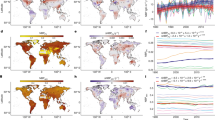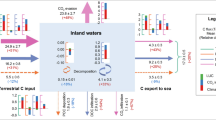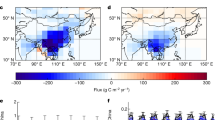Abstract
The global land and ocean carbon sinks have increased proportionally with increasing carbon dioxide emissions during the past decades1. It is thought that Northern Hemisphere lands make a dominant contribution to the global land carbon sink2,3,4,5,6,7; however, the long-term trend of the northern land sink remains uncertain. Here, using measurements of the interhemispheric gradient of atmospheric carbon dioxide from 1958 to 2016, we show that the northern land sink remained stable between the 1960s and the late 1980s, then increased by 0.5 ± 0.4 petagrams of carbon per year during the 1990s and by 0.6 ± 0.5 petagrams of carbon per year during the 2000s. The increase of the northern land sink in the 1990s accounts for 65% of the increase in the global land carbon flux during that period. The subsequent increase in the 2000s is larger than the increase in the global land carbon flux, suggesting a coincident decrease of carbon uptake in the Southern Hemisphere. Comparison of our findings with the simulations of an ensemble of terrestrial carbon models5,8 over the same period suggests that the decadal change in the northern land sink between the 1960s and the 1990s can be explained by a combination of increasing concentrations of atmospheric carbon dioxide, climate variability and changes in land cover. However, the increase during the 2000s is underestimated by all models, which suggests the need for improved consideration of changes in drivers such as nitrogen deposition, diffuse light and land-use change. Overall, our findings underscore the importance of Northern Hemispheric land as a carbon sink.
This is a preview of subscription content, access via your institution
Access options
Access Nature and 54 other Nature Portfolio journals
Get Nature+, our best-value online-access subscription
$29.99 / 30 days
cancel any time
Subscribe to this journal
Receive 51 print issues and online access
$199.00 per year
only $3.90 per issue
Buy this article
- Purchase on Springer Link
- Instant access to full article PDF
Prices may be subject to local taxes which are calculated during checkout




Similar content being viewed by others
Data availability
The decadal CO2 flux data that support the findings of this study are available in the Extended Data tables. Annual flux data from the two-box model and other models are available at http://dods.lsce.ipsl.fr/invsat/PC/. Atmospheric CO2 data are available from the Scripps Institution for Oceanography (SIO) website http://scrippsco2.ucsd.edu/data/atmospheric_co2/sampling_stations for MLO, LJO and SPO stations and from the ESRL GLOBALVIEW-plus CO2 open access dataset for other stations (https://www.esrl.noaa.gov/gmd/ccgg/obspack/our_products.php).
References
Ballantyne, A. P., Alden, C. B., Miller, J. B., Tans, P. P. & White, J. W. C. Increase in observed net carbon dioxide uptake by land and oceans during the past 50 years. Nature 488, 70–72 (2012).
Tans, P. P., Fung, I. Y. & Takahashi, T. Observational constraints on the global atmospheric CO2 budget. Science 247, 1431–1438 (1990).
Keeling, C. D., Piper, S. C. & Heimann, M. Aspects of Climate Variability in the Pacific and the Western Americas Vol. 55 (ed. Peterson, D. H.) 305–363 (AGU, 1989).
Wang, Y., Li, M. & Shen, L. Accelerating carbon uptake in the Northern Hemisphere: evidence from the interhemispheric difference of atmospheric CO2 concentrations. Tellus B 65, 20334 (2013).
Sitch, S. et al. Recent trends and drivers of regional sources and sinks of carbon dioxide. Biogeosciences 12, 653–679 (2015).
Ciais, P. et al. Can we reconcile atmospheric estimates of the Northern terrestrial carbon sink with land-based accounting? Curr. Opin. Environ. Sustain. 2, 225–230 (2010).
Pan, Y. D. et al. A large and persistent carbon sink in the world’s forests. Science 333, 988–993 (2011).
Le Quéré, C. et al. Global carbon budget 2016. Earth Syst. Sci. Data 8, 605–649 (2016).
Boden, T. A., Marland, G. & Andres, R. J. Global, regional, and national fossil-fuel CO2 emissions. In Trends: A Compendium of Data on Global Change (Carbon Dioxide Information Analysis Center, US Department of Energy, 2013).
Xu, L. et al. Temperature and vegetation seasonality diminishment over northern lands. Nat. Clim. Change 3, 581–586 (2013).
Graven, H. D. et al. Enhanced seasonal exchange of CO2 by northern ecosystems since 1960. Science 341, 1085–1089 (2013).
Bond-Lamberty, B., Bailey, V. L., Chen, M., Gough, C. M. & Vargas, R. Globally rising soil heterotrophic respiration over recent decades. Nature 560, 80–83 (2018).
Francey, R. J. & Frederiksen, J. S. The 2009–2010 step in atmospheric CO2 interhemispheric difference. Biogeosciences 13, 873–885 (2016).
Liu, Z. et al. Reduced carbon emission estimates from fossil fuel combustion and cement production in China. Nature 524, 335–338 (2015).
Boggs, P. T. & Rogers, J. E. Orthogonal Distance Regression. Report No. NISTIR 89–4197 (National Institute of Standards and Technology, 1990).
Conway, T. J. & Tans, P. P. Development of the CO2 latitude gradient in recent decades. Glob. Biogeochem. Cycles 13, 821–826 (1999).
Le Quere, C. et al. Saturation of the Southern Ocean CO2 sink due to recent climate change. Science 316, 1735–1738 (2007).
Landschützer, P. et al. The reinvigoration of the Southern Ocean carbon sink. Science 349, 1221–1224 (2015).
Brienen, R. J. W. et al. Long-term decline of the Amazon carbon sink. Nature 519, 344–348 (2015).
Houghton, R. A. et al. Carbon emissions from land use and land-cover change. Biogeosciences 9, 5125–5142 (2012).
Patra, P. K. et al. Transport mechanisms for synoptic, seasonal and interannual SF6 variations and “age” of air in troposphere. Atmos. Chem. Phys. 9, 1209–1225 (2009).
Hourdin, F. et al. The LMDZ4 general circulation model: climate performance and sensitivity to parametrized physics with emphasis on tropical convection. Clim. Dyn. 27, 787–813 (2006).
Heimann, M. & Körner, S. The Global Atmospheric Tracer Model TM3. Technical Report No. 5 (Max Planck Institute for Biogeochemistry, 2003).
Prather, M. J., Holmes, C. D. & Hsu, J. Reactive greenhouse gas scenarios: Systematic exploration of uncertainties and the role of atmospheric chemistry. Geophys. Res. Lett. 39, L09803 (2012).
Patra, P. K. et al. TransCom model simulations of CH4 and related species: linking transport, surface flux and chemical loss with CH4 variability in the troposphere and lower stratosphere. Atmos. Chem. Phys. 11, 12813–12837 (2011).
Rödenbeck, C. et al. Global surface-ocean pCO2 and sea–air CO2 flux variability from an observation-driven ocean mixed-layer scheme. Ocean Sci. 9, 193–216 (2013).
Landschützer, P., Gruber, N. & Bakker, D. C. E. A 30 Years Observation-based Global Monthly Gridded Sea Surface pCO 2 Product from 1982 through 2011. https://doi.org/10.3334/CDIAC/OTG.SPCO2_1982_2011_ETH_SOM-FFN (Carbon Dioxide Information Analysis Center, US Department of Energy, 2015).
Chevallier, F. et al. CO2 surface fluxes at grid point scale estimated from a global 21 year reanalysis of atmospheric measurements. J. Geophys. Res. D 115, D21307 (2010).
Rödenbeck, C., Houweling, S., Gloor, M. & Heimann, M. CO2 flux history 1982–2001 inferred from atmospheric data using a global inversion of atmospheric transport. Atmos. Chem. Phys. Discuss. 3, 2575–2659 (2003).
Denning, A. S., Fung, I. Y. & Randall, D. Latitudinal gradient of atmospheric CO2 due to seasonal exchange with land biota. Nature 376, 240–243 (1995).
Liu, X. et al. Enhanced nitrogen deposition over China. Nature 494, 459–462 (2013).
Thomas, R. Q., Canham, C. D., Weathers, K. C. & Goodale, C. L. Increased tree carbon storage in response to nitrogen deposition in the US. Nat. Geosci. 3, 13–17 (2010).
Che, H. Z. et al. Analysis of 40 years of solar radiation data from China, 1961–2000. Geophys. Res. Lett. 32, L06803 (2005).
Keeling, C. D., Piper, S. C. et al. Exchanges of Atmospheric CO 2 and 13 CO 2 with the Terrestrial Biosphere and Oceans from 1978 to 2000. I Global Aspects (University of California, San Diego, Scripps Institution of Oceanography, 2001).
Thoning, K. W., Tans, P. P. & Komhyr, W. D. Atmospheric carbon dioxide at Mauna Loa Observatory: 2. Analysis of the NOAA GMCC data, 1974–1985. J. Geophys. Res. D 94, 8549–8565 (1989).
Masarie, K. A., Peters, W., Jacobson, A. R. & Tans, P. P. ObsPack: a framework for the preparation, delivery, and attribution of atmospheric greenhouse gas measurements. Earth Syst. Sci. Data 6, 375–384 (2014).
Dee, D. P. et al. The ERA-Interim reanalysis: configuration and performance of the data assimilation system. Q. J. R. Meteorol. Soc. 137, 553–597 (2011).
Blasing, T. J., Broniak, C. T. & Marland, G. The annual cycle of fossil-fuel carbon dioxide emissions in the United States. Tellus B 57, 107–115 (2005).
Kalnay, E. et al. The NCEP/NCAR 40-year reanalysis project. Bull. Am. Meteorol. Soc. 77, 437–472 (1996).
Chevallier, F. On the statistical optimality of CO2 atmospheric inversions assimilating CO2 column retrievals. Atmos. Chem. Phys. 15, 11133–11145 (2015).
Takahashi, T. et al. Climatological mean and decadal change in surface ocean pCO2, and net sea-air CO2 flux over the global oceans. Deep Sea Res. II 56, 554–577 (2009).
van der Werf, G. R. et al. Global fire emissions estimates during 1997–2016. Earth Syst. Sci. Data 9, 697–720 (2017).
Mikaloff Fletcher, S. E. et al. Inverse estimates of anthropogenic CO2 uptake, transport, and storage by the ocean. Glob. Biogeochem. Cycles 20, https://doi.org/10.1029/2005GB002530 (2006).
Takahashi, T. et al. Global sea–air CO2 flux based on climatological surface ocean pCO2, and seasonal biological and temperature effects. Deep Sea Res. II 49, 1601–1622 (2002).
Rödenbeck, C. Estimating CO 2 Sources and Sinks from Atmospheric Mixing Ratio Measurements using a Global Inversion of Atmospheric Transport. Technical Report No. 6 (Max-Planck-Institut für Biogeochemie, 2005).
Acknowledgements
We acknowledge the ocean modellers and the Dynamic Global Vegetation modellers (TRENDY-V4) who provided simulations for the global carbon budget assessment in ref. 8. P.C. acknowledges support from the European Research Council Synergy project SyG-2013-610028 IMBALANCE-P and the ANR CLAND Convergence Institute. We thank the staff of the Scripps Institution of Oceanography (SIO), the NOAA ESRL, the Japan Meteorological Agency (JMA) for the RYO station and the Izana Observatory/Meteorological State Agency of Spain (IO-MSAS) for the IZO station, who contributed to the collection of atmospheric data used in this study, in particular the long-term records from Mauna Loa and the South Pole.
Reviewer information
Nature thanks Sander Houweling and the other anonymous reviewer(s) for their contribution to the peer review of this work.
Author information
Authors and Affiliations
Contributions
The study was conceived by P.C. and developed by P.C., J.T. and X.W. Simulations with the TM3 and LMDZ transport models were performed by C.R. and F.C. All other authors reviewed and provided input on the manuscript.
Corresponding author
Ethics declarations
Competing interests
The authors declare no competing interests.
Additional information
Publisher’s note: Springer Nature remains neutral with regard to jurisdictional claims in published maps and institutional affiliations.
Extended data figures and tables
Extended Data Fig. 1 Evolution of the interhemispheric CO2 gradient and of CO2 emissions from fossil fuels and cement.
The interhemispheric CO2 gradient, defined by the difference in observed mixing ratios between the MLO and SPO monitoring stations (blue), and the global CO2 emissions from fossil-fuel and cement obtained from CDIAC (red), both shown from 1958 to 2013.
Extended Data Fig. 2 Interhemispheric CO2 gradient plotted against fossil-fuel CO2 emissions for each decade from the 1960s to the 2010s, and IG–F slopes in the 1980s, 1990s and 2000s.
a, Scatter plots of the interhemispheric gradient plotted against emissions from fossil fuels and cement, obtained from CDIAC, for different Northern Hemisphere long-term monitoring stations with sufficient data coverage (see Methods). The SPO station is always taken as the reference from which to calculate the interhemispheric gradient from each station. A station is marked by an asterisk if the correlation coefficient (r2) between interhemispheric gradient and emissions is greater than 0.3 during both period 1 (first available year to 1999) and period 2 (2000 to 2009). b, Decadal linear regression IG–F slopes at the long-term monitoring stations for which the correlation coefficient between interhemispheric gradient and emissions is greater than 0.3 during any of the past three decades. The SPO station is taken as the reference from which to calculate the interhemispheric gradient for each station. The slope was calculated at each site and error bars represent the orthogonal data regression slope uncertainties.
Extended Data Fig. 3 The proportion of fossil-fuel emissions by latitude and longitude for each decade from the 1980s, and simulated IG–F slopes from ~1980–1999 and in the 2000s with three different atmospheric transport models.
a, b, Fraction of global fossil-fuel CO2 emissions in each latitude band (a) and in each longitude band (b) during 1980–2013. c, Slope of orthogonal least square linear regressions between modelled interhemispheric gradient for a simulated fossil-fuel CO2 tracer (see Methods) and fossil CO2 emissions. Three global 3D transport models were used with interannual winds to obtain these results (Methods), namely LMDZ with ERA-Interim ECMWF winds (top), TM3 with ERA-Interim ECMWF winds (middle) and TM3 with NCEP winds (bottom). LMDZ and TM3 were prescribed time-varying maps of fossil-fuel and cement emissions. The modelled distribution of the fossil-fuel CO2 tracer in the atmosphere was sampled at the location of each long-term station. The slopes are shown for two periods: from around 1980–1999 (the first year of observations at each site is around 1980) and 2000–2009. The modelled fossil-fuel CO2 tracer at SPO is taken as a reference from which to calculate the interhemispheric gradient at all sites.
Extended Data Fig. 4 Ocean flux differences between the Northern and Southern hemispheres from ocean biogeochemical models, data-driven models and inversions.
a, Interhemispheric difference in ocean fluxes (ON − OS) between 1959 and 2013, obtained from the seven ocean models used in ref. 17. b, Estimates of (ON − OS) from MACC and JENA inversion results over the period they cover, and from the two ocean data-driven models described in the Methods26,27. c, LN inferred from the two-box inversion, with (ON − OS) being the mean value from seven ocean models (black line) and from each of the two data-driven models (red and blue lines)26,27.
Extended Data Fig. 5 Northern land sink from inversions, with decadal mean values shown, and the sensitivity of the northern land sink to interhemispheric mixing time.
a, Values of the northern land sink obtained from two-box inversion (black, with 1-sigma uncertainty in grey) and from MACC (dark blue) and JENA (light blue) 3D inversions. In the 3D inversions, LN is calculated by summing the flux of land grid cells north of the Equator. Numbers indicate decadal mean values, and the numbers in brackets denote the change in LN from one decade to the next. b, Comparison of LN inferred by the two-box inversion in the control case (black) in which the interhemispheric mixing time is set constant at 1.4 years, and in a scenario (red) in which it is inferred from SF6 measurements to have decreased linearly by 0.57% per year from 1990 to 2013, corresponding to the fraction of the decrease observed in ref. 21 that was not explained by a southward shift in geographic distribution of SF6 emissions.
Extended Data Fig. 6 Trend in ‘rectifier interhemispheric CO2 gradient’ simulated with TM3 related to the trend of atmospheric transport convoluted by trends in the seasonal amplitude and phase of land–atmosphere fluxes.
Scatter diagrams of simulated change in interhemispheric gradient with TM3 and ERA-interim wind fields (see Methods) related to the trend of atmospheric transport convoluted by trends in the seasonal amplitude and phase of land–atmosphere fluxes, called ‘trend in rectifier’. The results are obtained by applying TM3 to variable maps of seasonal land fluxes created by subtracting the mean seasonal cycle and the long-term mean from the inverted land fluxes (at every grid cell). Then, the simulated CO2 field was sampled at the same location as each long-term station, and the difference from the value obtained at the SPO station is plotted as interhemispheric gradient due to ‘trend in rectifier’. The absence of any trend in interhemispheric gradient from ‘trend in rectifier’-related mechanisms suggests that this process does not explain any trend in the observed interhemispheric gradient that would be aliased as trends in LN in the two-box inversion.
Extended Data Fig. 7 Northern land sink simulated by different land carbon-cycle models.
a, TRENDY V2 ensemble (1959–2012), b, TRENDY V4 ensemble used in this study (1959–2014), c, MsTMIP ensemble with models considering nitrogen deposition change (1959–2010), d, MsTMIP ensemble with models not considering nitrogen deposition change (1959–2010). MsTMIP models with CO2 sources in the Northern Hemisphere and/or global land sink that lie outside the observed range from the global CO2 budget of ref. 17 were not used.
Rights and permissions
About this article
Cite this article
Ciais, P., Tan, J., Wang, X. et al. Five decades of northern land carbon uptake revealed by the interhemispheric CO2 gradient. Nature 568, 221–225 (2019). https://doi.org/10.1038/s41586-019-1078-6
Received:
Accepted:
Published:
Issue Date:
DOI: https://doi.org/10.1038/s41586-019-1078-6
This article is cited by
-
An emergent constraint on the thermal sensitivity of photosynthesis and greenness in the high latitude northern forests
Scientific Reports (2024)
-
Transition from positive to negative indirect CO2 effects on the vegetation carbon uptake
Nature Communications (2024)
-
Changes in land use and management led to a decline in Eastern Europe’s terrestrial carbon sink
Communications Earth & Environment (2023)
-
Evidence and attribution of the enhanced land carbon sink
Nature Reviews Earth & Environment (2023)
-
Diagnosing destabilization risk in global land carbon sinks
Nature (2023)
Comments
By submitting a comment you agree to abide by our Terms and Community Guidelines. If you find something abusive or that does not comply with our terms or guidelines please flag it as inappropriate.



